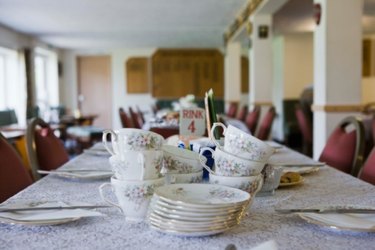
Porcelain dinnerware is perennially popular because it is both durable and attractive. Porcelain cleans easily, soaks without damage and does not stain. Porcelain is usually white, and the high temperature firing process used to produce it often makes it so translucent you can see your hand through it when it's held up to a light. Porcelain also holds decorative designs that do not fade with use. Porcelain dinnerware is made of a hard-paste composition that looks like glass when it breaks.
Porcelain
Video of the Day
Ceramics refers to several clay-production processes requiring heat. The word "ceramics" comes from Greek "keramikos," which means pottery, and is based on a Sanskrit root meaning "to burn." Porcelain differs from other ceramics such as clay pottery, earthenware and stoneware in the fineness and whiteness of the production material. It also differs in the firing temperature -- porcelain firing temperatures are up to 2,500 degrees Fahrenheit. Porcelain is made of 50 percent kaolin clay, 25 percent feldspar and 25 percent quartz. Bone china is composed of a base of bone ash, which allows a firing temperature as low as 1450 degrees Fahrenheit for the same or better result. Bone china is less brittle than other porcelain products not comprised of bone ash. Both bone china and porcelain are vitreous. China becomes vitreous when heated at a temperature that allows the clay and feldspar or bone ash to bind together as one product.
Video of the Day
Durability
A porcelain surface is hard and resistant to chipping or cracking. Noritake reports that porcelain and bone china are the most durable materials for dinnerware, and conducted tests to compare its porcelain products with everyday china to prove this claim. The same tests reveal that porcelain is also dishwasher-safe. Nikko, another major manufacturer of china, reports the recent development and sale of a reinforced porcelain that is blue and has higher durability than other porcelain products.
Decoration
The most durable porcelain dinnerware does not contain gold or platinum. If you want to use your porcelain dinnerware every day, choose a pattern without gold or platinum trim, which is easily damaged by exposure to excessive heat, lemon-based dishwashing liquids or the microwave. Figurative decorations may be hand-painted, but most manufacturers use decals for production dinnerware. An underglaze covers the porcelain body and a low firing temperature creates a fine surface for the decoration. Some pieces have several layers of glaze, each of which is fired at a lower temperature than the one before. Each layer of glaze creates added protection for the porcelain.
Care
Porcelain can withstand use, the dishwasher and maybe the microwave but it is still fine china. Porcelain can break if dropped on a hard surface. Although the glaze is high-fired, you can scratch the surface with utensils, particularly knives. Valuable porcelain should be hand-washed because a dishwasher always introduces the possibility that items could knock against each other during the cycle. Handle your porcelain dinnerware with care and it will last for generations.